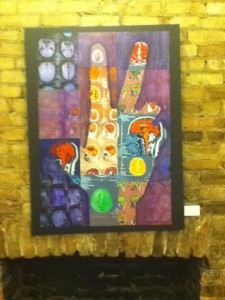A Timely Exhibit of Burmese Artists
April 16 2018 Update: It’s been more than six years since I attended this exhibit of Burmese artists in exile, held on the cusp of pivotal changes in the Asian country. It is distressing to know that despite much positive change, recent months have seen human rights abuses directed against the Rohingya people. There was no sign of this on the horizon when I wrote up the exhibit in 2012. It’s a pity that when positive change takes place—like the Arab Spring of last decade, and the dissolution of Yugoslavia in the 1990s—it is often followed by a decline in freedoms, as rivalries are loosed and opportunistic politicians angle for ways to help themselves gain or maintain power.
—-
 I was excited then when I entered Gallery 35 last Saturday night, and detected a buzz of activity in the large, lighted space. I was first aware of the crowd–New Yorkers you might see at any art openings plus the Burmese artists, their friends and family. The work was striking, with much of it overtly on message about the years of military repression they’ve endured, but also full of brilliant color, vibrant shapes and strong composition. There was painting, fiber, sculpture and photography on display. I had a conversation with female painter and performance artist Chaw Ei Thein. She and others I spoke with are pleased, but wary about the regime’s new policy of relaxation. They hope it continues, but none of them is ready to believe in it wholeheartedly. Chaw Ei Thein placed this statement on her website in September 2011, prior to the current relaxation of repression:
I was excited then when I entered Gallery 35 last Saturday night, and detected a buzz of activity in the large, lighted space. I was first aware of the crowd–New Yorkers you might see at any art openings plus the Burmese artists, their friends and family. The work was striking, with much of it overtly on message about the years of military repression they’ve endured, but also full of brilliant color, vibrant shapes and strong composition. There was painting, fiber, sculpture and photography on display. I had a conversation with female painter and performance artist Chaw Ei Thein. She and others I spoke with are pleased, but wary about the regime’s new policy of relaxation. They hope it continues, but none of them is ready to believe in it wholeheartedly. Chaw Ei Thein placed this statement on her website in September 2011, prior to the current relaxation of repression:
Many of my friends are in prison, far away and inaccessible. There are over 2000 political prisoners in Burma. Some have been sentenced to 56 years of imprisonment, some 65, some 102. All are committed to their fight for freedom and justice in Burma, and for our people. I am lucky because I am not in prison like them. But I always think of them: how they spend their time in the prison, and how they have sacrificed. I cannot help them to be free. So I am doing this performance as a tribute to them and what they have done for us. In this performance, I explore the “poun-zan”: a form of torture common in Burmese prisons, in which prisoners must hold a physically excruciating and psychologically humiliating position for a long period of time. My performance is their real performance in those prisons.
I photographed her two-fingered peace sign painting in the Gallery 35 exhibit. If you’re in New York I urge you to check the gallery’s hours and go see the powerful and beautiful work in this timely exhibit. It is up until February 25, and there will even be a closing reception on that Saturday next month. Meantime, here are pictures I took at the opening last week. // more . . .
